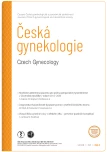Early treatment of vulvar synechiae in childhood – prevention of late complications
Authors:
A. Janštová 1,2; Marta Nováčková 1
Authors‘ workplace:
Gynekologicko-porodnická klinika, 2. LF UK a FN Motol, Praha 2 Gynekologicko-porodnické oddělení, Krajská zdravotní a. s., Nemocnice Most o. z.
1
Published in:
Ceska Gynekol 2023; 88(5): 384-389
Category:
doi:
https://doi.org/10.48095/cccg2023384
Overview
Synechiae of the vulva occurs especially in girls in the so-called resting hormonal period with a minimal serum concentration of estrogens. If the external genitalia of the girl are not treated properly, the mucous membrane of the vaginal entrance is not regularly checked and mechanically removed, then the smegma of the opposite mucous membranes of the vulva can stick together. The place of the adhesion of epithelium in the vaginal introitus can be covered by a new epithelium and can create a firm adhesion, synechiae of the vulva, which is usually asymptomatic and is discovered incidentally during pediatric examination. Clinically significant vulvar synechiae can cause impaired bladder evacuation and recurrent lower urinary tract infections. Dissection of synechiae in the stage of conglutination or thin adhesion is performed manually on an outpatient basis, but extensive and firm adhesions must be divided surgically under general anesthesia. Local application of cream with estriol or betamethasone is also used for the therapy of synechiae of the vulva, but this treatment is more time-consuming compared to rapid manual separation and requires good compliance of the girls and their parents. The prevention of synechiae is based on the education of parents by pediatricians and gynecologists about the need for regular checks of the external genitalia and sufficient hygiene.
Keywords:
conservative therapy – vulvovaginitis – conglutination vulvae infantum – synechiae of the vulva – manual separation
Sources
1. Dowlut-McElroy T, Higgins J, Williams KB et al. Treatment of prepubertal labial adhesions: a randomized controlled trial. J Pediatr Adolesc Gynecol 2019; 32 (3): 259–263. doi: 10.1016/ j.jpag.2018.10.006.
2. Kumetz LM, Quint EH, Fisseha S et al. Estrogen treatment success in recurrent and persistent labial agglutination. J Pediatr Adolesc Gynecol 2006; 19 (6): 381–384. doi: 10.1016/ j.jpag.2006.09.008.
3. Lee IO, Pak HY, Chung JE. Demographic characteristics of labial adhesion in South Korea: a population-based study from 2010 to 2014. BMJ Paediatr Open 2018; 2 (1): e000276. doi: 10.1136/bmjpo-2018-000 276.
4. Hirsch P, Leclerc M, Rybojad M et al. Female genital chronic graft-versus-host disease: importance of early diagnosis to avoid severe complications. Transplantation 2012; 93 (12): 1265–1269. doi: 10.1097/TP.0b013e31824f3 dcd.
5. Bacon JL, Romano ME, Quint EH. Clinical recommendation: labial adhesions. J Pediatr Adolesc Gynecol 2015; 28 (5): 405–409. doi: 10.1016/j.jpag.2015.04.010.
6. Gonzalez D, Anand S, Mendez MD. Labial adhesions. In: StatPearls. Treasure Island (FL): StatPearls Publishing 2023.
7. Schober J, Dulabon L, Martin-Alguacil N et al. Significance of topical estrogens to labial fusion and vaginal introital integrity. J Pediatr Adolesc Gynecol 2006; 19 (5): 337–339. doi: 10.1016/ j.jpag.2006.06.004.
8. Chubanovová N, Chmel R Jr, Kelčík R et al. Hymenální atrezie – vzácná kongenitální anomálie s rizikem pozdního stanovení diagnózy. Ceska Gynekol 2022; 87 (2): 118–123. doi: 10.48095/cccg2022118.
9. Hobzová P, Chubanovová N, Nováčková M. Distální vaginální ageneze a diferenciální diagnostika dalších příčin hematokolpos. Ceska Gynekol 2022; 87 (5): 350–355. doi: 10.48095/ cccg2022350.
10. Chmel R jr, Pastor Z, Mužík M et al. Syndrom Mayer-Rokitansky-Küster-Hauser – ageneze dělohy a pochvy: aktuální znalosti a terapeutické možnosti. Ceska Gynekol 2019; 84 (5): 386–392.
11. Mohapatra I, Samantaray SR. Labial fusion recurrence in a prepubertal girl: a case report and review of literature. Cureus 2022; 14 (6): e26059. doi: 10.7759/cureus.26059.
12. Cağlar MK. Serum estradiol levels in infants with and without labial adhesions: the role of estrogen in the etiology and treatment. Pediatr Dermatol 2007; 24 (4): 373–375. doi: 10.1111/j.1525-1470.2007.00493.x.
13. Eroğlu E, Yip M, Oktar T et al. How should we treat prepubertal labial adhesions? Retrospective comparison of topical treatments: estrogen only, betametasone only, and combination estrogen and betametasone. J Pediatr Adolesc Gynecol 2011; 24 (6): 389–391. doi: 10.1016/j.jpag.2011.07.015.
14. Mayoglou L, Dulabon L, Martin-Alguacil N et al. Success of treatment modalities for labial fusion: a retrospective evaluation of topical and surgical treatments. J Pediatr Adolesc Gynecol 2009; 22 (4): 247–250. doi: 10.1016/ j.jpag.2008.09.003.
15. Kumar RK, Sonika A, Charu C et al. Labial adhesions in pubertal girls. Arch Gynecol Obstet 2006; 273 (4): 243–245. doi: 10.1007/ s00404-005-0060-8.
16. Plagens-Rotman K, Drejza M, Kędzia W et al. Gynaecological infections in paediatric and adolescent gynaecology: a review of recommendations. Postepy Dermatol Alergol 2021; 38 (5): 734–739. doi: 10.5114/ada.2021.110084.
17. Jarešová V, Hrochová V, Šottner O et al. Synechia vulvae infantum – výskyt na Gynekologicko-porodnické klinice 1. LF UK a FN na Bulovce v období let 2001 až 2005. Ceska Gynekol 2007; 72 (2): 131–135.
18. Huseynov M, Hakalmaz AE. Labial adhesion: new classification and treatment protocol. J Pediatr Adolesc Gynecol 2020; 33 (4): 343–348. doi: 10.1016/j.jpag.2020.03.005.
19. Norris JE, Elder CV, Dunford AM et al. Spontaneous resolution of labial adhesions in pre-pubertal girls. J Paediatr Child Health 2018; 54 (7): 748–753. doi: 10.1111/jpc.13847.
20. Granada C, Sokkary N, Sangi-Haghpeykar H et al. Labial adhesions and outcomes of office management. J Pediatr Adolesc Gynecol 2015; 28 (2): 109–113. doi: 10.1016/j.jpag.2014.06.004.
21. Leung AK, Robson WL, Kao CP et al. Treatment of labial fusion with topical estrogen therapy. Clin Pediatr (Phila) 2005; 44 (3): 245–247. doi: 10.1177/000992280504400308.
22. Rome ES. Vulvovaginitis and other common vulvar disorders in children. Endocr Dev 2012; 22 : 72–83. doi: 10.1159/000326634.
Labels
Paediatric gynaecology Gynaecology and obstetrics Reproduction medicineArticle was published in
Czech Gynaecology

2023 Issue 5
Most read in this issue
- Early treatment of vulvar synechiae in childhood – prevention of late complications
- Relugolix combination therapy and symptoms of uterine myomatosis – selected case reports of indication spectrum and treatment outcomes
- Implementation of the ERAS protocol in gynecology and oncogynecology – evaluation of a pilot study
- Nascent myoma as a cause of urinary retention
